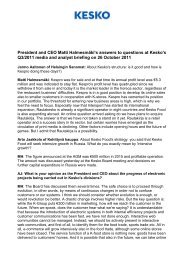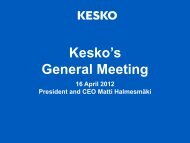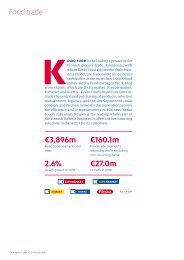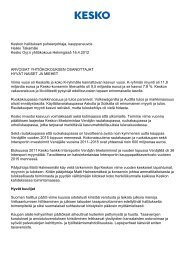You also want an ePaper? Increase the reach of your titles
YUMPU automatically turns print PDFs into web optimized ePapers that Google loves.
Year <strong>2007</strong><br />
Divisions The Group<br />
Financial<br />
statements<br />
Further information<br />
Leases in which assets are leased out by the Group, and substantially<br />
all the risks and rewards incident to ownership are transferred to the lessee,<br />
are classified as finance leases. Assets leased under such contracts<br />
are recognised as receivables in the balance sheet and are stated at<br />
present value. The financial income from finance leases is determined so<br />
as to achieve a constant periodic rate of return on the remaining net<br />
investment for the lease term.<br />
Leases in which risks and rewards incident to ownership are not<br />
transferred to the lessee are classified as operating leases. Lease payments<br />
related to them are recognised in the income statement on a<br />
straight-line basis over the lease term.<br />
In sale and leaseback transactions the sale price and the future lease<br />
payments are usually interdependent. If a sale and leaseback transaction<br />
results in a finance lease, any excess of sales proceeds over the carrying<br />
amount is not immediately recognised as income. Instead it is deferred<br />
and amortised over the lease term. If a sale and leaseback transaction<br />
results in an operating lease and the transaction is established at fair<br />
value, any profit or loss is recognised immediately.<br />
If the sale price is below fair value, any profit or loss is recognised<br />
immediately unless the loss is compensated by future lease payments at<br />
below market price, in which case the loss is deferred and amortised over<br />
the period for which the asset is expected to be used. If the sale price is<br />
above fair value, the excess over fair value is deferred and amortised over<br />
the period for which the asset is expected to be used. If the fair value at<br />
the time of a sale and leaseback transaction is less than the carrying<br />
amount of the asset, a loss equal to the amount of the difference between<br />
the carrying amount and fair value is recognised immediately.<br />
Inventories<br />
Inventories are measured at the lower of cost and net realisable value.<br />
Net realisable value is the estimated selling price in the ordinary course<br />
of business less the estimated costs necessary to make the sale. The cost<br />
is primarily assigned by using the weighted average cost formula. The<br />
cost of certain classifications of inventory is assigned by using the FIFO<br />
formula. The cost of finished products comprises all costs of purchase<br />
including freight. The cost of self-constructed goods comprise all costs of<br />
conversion including direct costs and allocations of variable and fixed<br />
production overheads.<br />
Trade receivables<br />
Trade receivables are recognised at the original invoice amount. Impairment<br />
is recognised when there is objective evidence of impairment loss.<br />
The Group has established a uniform basis for the determination of<br />
impairment of trade receivables based on the time receivables have been<br />
outstanding. In addition, impairment is recognised if there is other evidence<br />
of a debtor's insolvency, bankruptcy or liquidation. Losses on loans<br />
and advances are recognised as an expense in the income statement.<br />
Assets held for sale and discontinued operations<br />
Assets (or a disposal group) and liabilities relating to discontinued operations<br />
are classified as held for sale, if their carrying amount will be recovered<br />
principally through the disposal of the assets rather than through<br />
continuing use. For this to be the case, the sale must be highly probable,<br />
the asset (or disposal group) must be available for immediate sale in its<br />
present condition subject only to terms that are usual and customary, the<br />
management must be committed to selling and the sale should be<br />
89<br />
expected to qualify for recognition as a completed sale within one <strong>year</strong><br />
from the date of classification.<br />
Non-current assets held for sale (or assets included in the disposal<br />
group) and assets and liabilities linked to a discontinuing operation are<br />
measured at the lower of the carrying amount and fair value net of estimated<br />
costs to sell. After an asset has been classified as held for sale, or<br />
if it is included in the disposal group, it is not depreciated. If the classification<br />
criterion is not met, the classification is reversed and the asset is<br />
measured at the lower of its balance sheet value prior to the classification<br />
less depreciation and impairment, and recoverable amount. A noncurrent<br />
asset held for sale and assets included in the disposal group classified<br />
as held for sale are disclosed separately in the balance sheet. Liabilities<br />
included in the disposal group of assets held for sale are also<br />
disclosed separately in the balance sheet. The profit from discontinued<br />
operations is disclosed as a separate line item in the income statement.<br />
The Group has classified certain real estate properties removed from<br />
business use as assets held for sale.<br />
Provisions<br />
A provision is recognised when the Group has a present legal or constructive<br />
obligation as a result of a past event, and it is probable that an outflow<br />
of resources embodying economic benefits will be required to settle<br />
the obligation, and that a reliable estimate can be made of the amount of<br />
the obligation. Provision amounts are reviewed at each balance sheet<br />
date and adjusted to reflect the current best estimate. Changes in provisions<br />
are recorded in the income statement in the same item in which the<br />
provision was originally recognised. The most significant part of the<br />
Group's provisions relates to warranties given to products sold by the<br />
Group, and to onerous leases.<br />
A warranty provision is recognised when a product fulfilling the<br />
terms is sold. The provision amount is based on historical experience<br />
about the level of warranty expenses. Leases become onerous if the<br />
leased premises become vacant, or if they are subleased at a rate lower<br />
than the original. A provision is recognised for an estimated loss from<br />
vacant lease premises over the remaining lease term, and for losses from<br />
subleased premises.<br />
Pension plans<br />
The Group operates several pension plans classified either as defined<br />
contribution plans or defined benefit plans. The contributions payable<br />
under defined contribution plans are recognised as an expense in the<br />
income statement of the period in which they incur.<br />
In defined benefit plans, after the Group has paid the amount for the<br />
period, obligations or assets may result. The pension obligation represents<br />
the present value of future cash flows from payable benefits. The<br />
present value of pension obligations has been calculated using the Projected<br />
Unit Credit Method. The assets corresponding to the pension obligation<br />
of the retirement benefit plan are carried at fair values at the balance<br />
sheet date. Actuarial gains and losses are recognised in the income<br />
statement for the average remaining service lives of the employees participating<br />
in the plan to the extent that they exceed 10 percent of the<br />
higher of the present value of the defined benefit plans and the fair value<br />
of assets belonging to the plan.<br />
Relating to the arrangements taken care of by the Kesko Pension<br />
Fund, the funded portion and the disability portion under the Finnish<br />
Employees' Pensions Act are treated as defined benefit plans. In addition,















